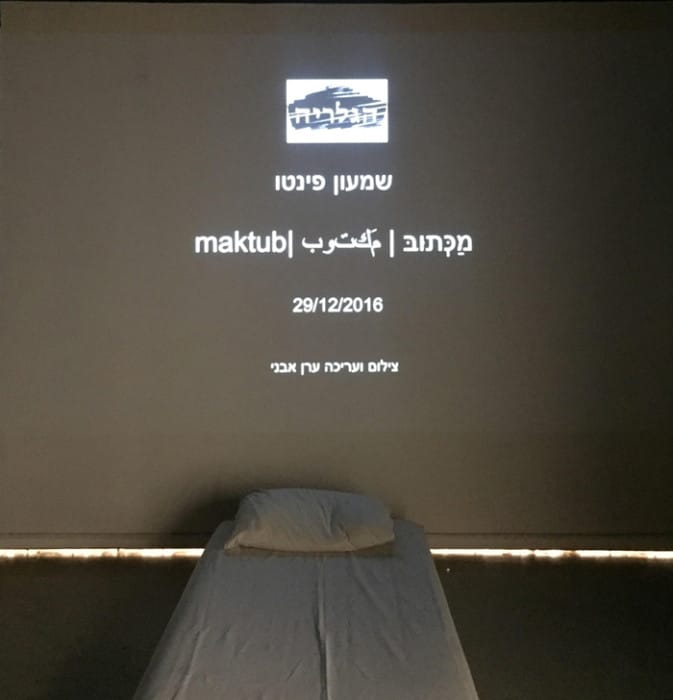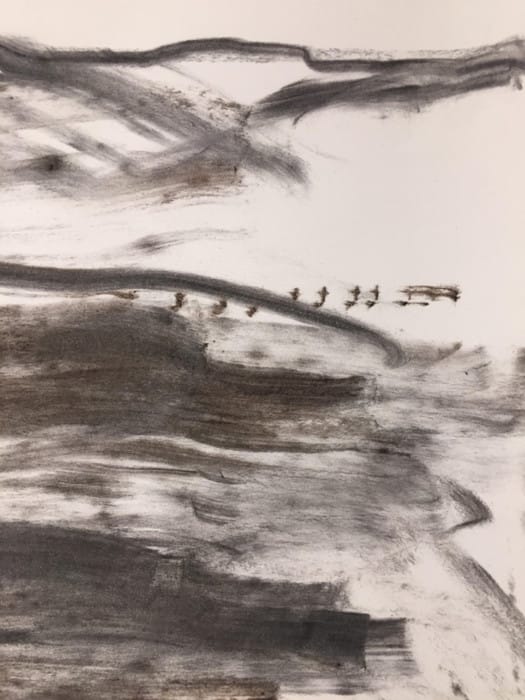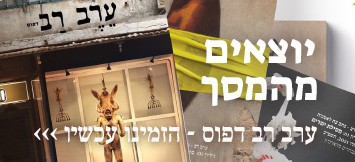Shimon Pinto returned to Kibbutz Be’eri, where he resided for one year as an external child from Arad. It appears that the initial experience that resurfaces in Pinto’s renewed encounter with Kibbutz Be’eri is the experience of freedom to observe things differently. The exhibit is indeed daunting and colorless; however, there prevails an internal bustle of freedom of action, and legitimacy to embark on an adventure and act differently than accustomed. Contrary to previous exhibits, in which he brought paintings that he painted in his studio in Jerusalem with him, and hung them on the walls of the gallery, this time he implemented action in the gallery space. The charcoal sketches and the central object of the exhibit are the outcome of the activity carried out in the gallery space, and which expressed Pinto’s desire to reconstruct something from the impetus inherent in his childhood, while observing it from his current perspective, as an adult artist, who is a newly observant Jew (hozer bitshuva), raising eight children and leading a religious life.
Of all the rituals recurring therein, Pinto reconstructed the bonfire – the kumzitz (campfire sing-along) – which was part of the atmosphere that prevailed in children’s lives on the kibbutz. The kumzitz always takes place on the margins of the expanse, outdoors, beyond the boundaries of what is permissible and what is prohibited. Pinto lit the bonfire on the perimeters of the Kibbutz, but did not convey it as an actual image for the exhibit. He used coals as charcoal to draw his sketches on large pieces of white paper descending from the ceiling to the floor. The sketches connect between the external landscape and internal imagination: a horizontal desert landscape accentuating the sand dunes in one sketch, and in another sketch, an angel with the face of an ox, wings spread forward, holding a quivering lance in his hands, an “angel of history” of sorts, drawn using dynamic charcoal strokes. Another sketch depicts a locked door or gate, and it is in the center of the wall, charred and sealed. The black minimalist sketches are astounding when it comes to a vibrant artist with a penchant for detail, the likes of Pinto.

Shimon Pinto, from the exhibit
Pinto has taken advantage of the architecture of the Be’eri Gallery, at the center of which is a closed, cube space, used to screen video art. This option not only inspired him to present a video work for the very first time, but also to offer an interesting approach the outer wall of the cube. In an activity lasting for several hours, Pinto coated the four outer walls with white plastic bags, tied together compactly on an iron lattice attached to the walls. The white sheath comprising the plastic bags created a feather-like surrealistic surface, which perhaps interrelates with the angel wings and creates a soft down-like wrapping for what is transpiring from within, inside the box: a bed and pillow, reminiscent of the kibbutz bed, and above the bed there is a video being screened, relating to Be’eri and a specific event in Pinto’s biography.
The rectangle that is the bed frame – a frame of privacy and dreams – is the only detail that Pinto tangibly restored in the gallery space. This is a wise choice, because the bed, which is a solitary object in the space, represents the home-not-home, the private expanse that is cut according to the measurements of the body floating within the public sphere and the physical existence of a boy who is far away from his parent’s home. The bed distinguishes day from night, consciousness from unconsciousness, and consequently facilitates the film’s being screened overhead, a clip based on a slice of memory: in the video we see the soft hands of a six year old boy (Pinto’s son) anxiously digging a hole in the arid desert-like soil, while in the background we hear his rapid shallow breaths. The feverish digging is halted by a short pause, in which an image of a barren tree fills the screen, and the loop returns to the hands digging in the earth.
Pinto restores his memory of being six years old, when he arrived at the cemetery of Kibbutz Be’eri with his mother in order to “look for her brother”. As a child he did not understand where the uncle that they came looking for was (Where?), and when his mother told him that his uncle was beneath the ground, he began digging fretfully in order to allow his uncle to breathe. This anxiety-ridden moment, encompassing his rapid shallow breathing, which is conveyed through a row of speakers, is contained within the white, winged cube, connecting different points in time to one essence, poetic, yet crass – uncouth and refined at once. The continuous positioning action resonates in a loop of the child’s digging, and it seems that the repetitiveness serves as a calming technique. Beneath every story of a child from outside the kibbutz, the bonfires and a kumzitz – there lies great apprehension. Pinto has succeeded in alluding to this without falling into the trap of melodrama.

Shimon Pinto, from the exhibit
At the closing event of the exhibit, the Ka’et Ensemble performed in the gallery – a group of five ultra-orthodox dancers who perform modern dance based on an inventory of movements deriving from the body language of Hassidut (Hassidism): the division of the body into the upper and lower portions, via the tying of the “gartel” (sash), movements of hyperexcitation and ecstasy, enthused shaking of the head, and at the height of the dance – the dispersion of a large “cloud” saturated with crushed and colorless disposal cups, another esthetic and material component of Hassidic multi-participant events, purely built on disposal dinning utensils.
The dance performance of Ka’et Ensemble suited Pinto’s exhibit perfectly – both in terms of the merging of faith and contemporary idiom, as well as from the point of the black-white brilliance. The hard core of this surprising dance performance also interplayed with the exhibit – the moments of anxiety and outburst, the danger of deviating from the boundaries of what is permissible and of overturning prohibitions.
*Posted Originally in Hebrew, on 25 January 2017













